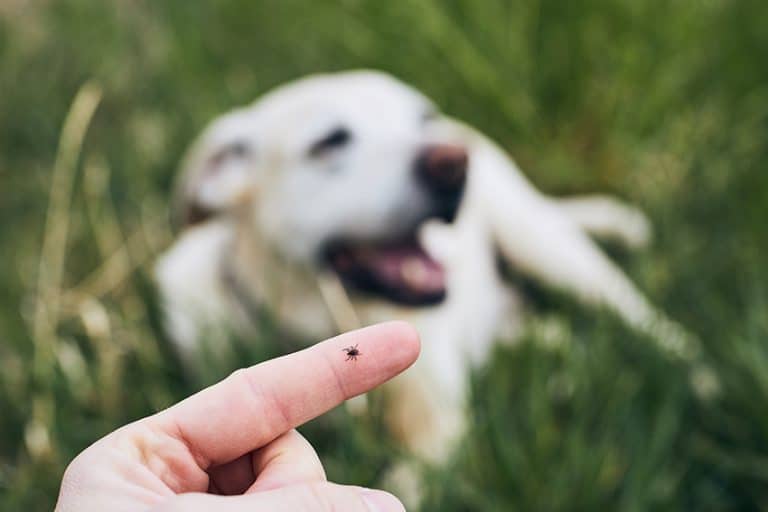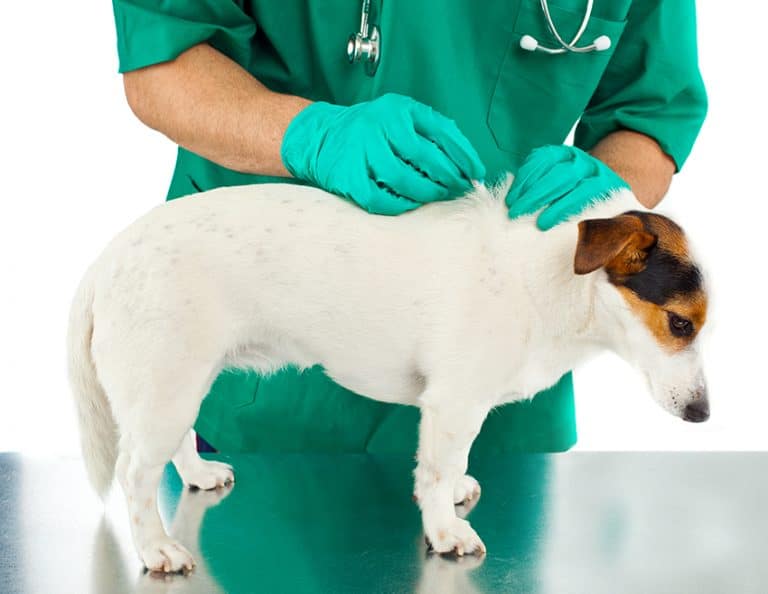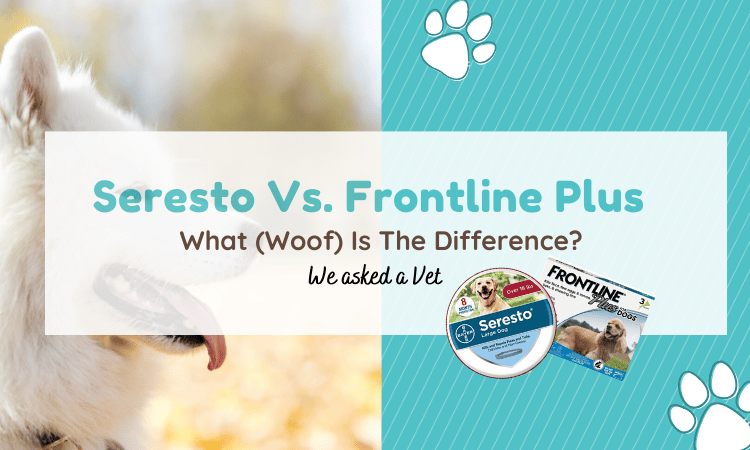
Application
Seresto collar is available as a unique ‘collar’ application where you simply pop the collar on your fur-iend and forget about it for up to 8 months. Ensure the collar is fitted suitably (can get 2 fingers underneath comfortably) and check it regularly to ensure it’s fitting well, just as you do with your dog’s regular collar.
Seresto collars are available in 2 sizes for dogs, up to 18lbs and over 18lbs weight. It may seem unusual given how much narrower the weight ranges are for other products but part of this is because you can trim the collar to a suitable size for your pooch.
As the whole collar is impregnated, when you cut the excess off you are reducing the amount of medication to which your dog is exposed to an appropriate dose for their size.
What does it kill?
Seresto has been proven to kill fleas on your dog within 24 hours and once the active ingredients have been absorbed into your dog’s fur, ticks are actively repelled without even having to bite to ingest the product.
Flea larvae are also targeted in your dog’s bedding while all stages of the ticks’ life cycles are targeted. Chewing lice may take up to 7 days to be eliminated from your dog. So, if your dog has an active infestation with lice your veterinary surgeon may advise you about initial treatment prior to using the collar.
Seresto collars can also reduce the risk of your dog becoming infected with Leishmania infantum (Leishmaniosis) caused by bites from sand flies. Though Seresto isn’t licensed for the control of mites such as Sarcoptes scabei, a study in 2012 did show that the medications within a collar do work to kill mites, though at a much slower rate of several weeks so again, your veterinarian will likely prescribe an alternative, faster acting treatment for an active infestation (Stanneck et al., 2012).
How does it work?
The ingredients in Seresto work by being absorbed into the body of the pest and binding to certain receptors which prevent nerves from communicating thus causing paralysis and death.
How long does it last for?
Seresto collars have been proven to last for up to 8 months in most conditions. Being water resistant, your pup can go swimming and you don’t need to remove the collar to bathe your dog though too much water or excessive shampooing may reduce the duration of efficacy.
This seems to mostly affect its activity against fleas. Clients have asked if they can just use the collar for a short period of time and save it for use months later; this isn’t recommended as if it’s not on your dog then it’s not protecting your dog from fleas and ticks.
Once the packaging has been opened, the collar will constantly release the medications over a sustained period of time, so it won’t last longer than 8 months whether or not it’s on your pup.
What are the active ingredients in Seresto?
- Imidacloprid: targets adult and larval fleas.
- Flumethrin: repels and kills all stages of a tick's life cycle.
How are the ingredients in Seresto delivered?
These then spread across the entire body through the lipid layer within your dog’s skin. Another plus with using these collars is that they are odorless and non-greasy.
How long does it take for Seresto to start working?
Are there any safety risks or possible side effects of Seresto?
Side effects of using a Seresto Collar:
- Itching: This is rare and usually lasts for only a few days after putting the collar. If your dog does this, check that the collar isn't too tight and is comfortable.
- Redness or Hair Loss: Again, this is very rare and usually only last for a short period of time without needing to remove the collar. If you want, you can remove the collar until signs have disappeared and pop it back on ensuring it's not too tight around your pup's neck.
- Dermatitis or Skin Lesions: This is exceptionally rare when using Seresto, but if this does occur to your dog you should remove the collar and consult your veterinarian as topical medication may be needed though signs generally resolve within a short period once the collar has been removed.
- Drooling, Fatigue, Difficulty Walking: These are side effects of the ingredients and are incredibly rare. These tend to be seen if a large dog collar is used on a small dog or on a cat where the dog receives an overdose. This is why we advise trimming the excess strap once you have fitted the collar to your dog.
What We Like About Seresto collar
- Long lasting and easy to apply
- Odourless and safe
- Safety clasp on collar in case your pup gets stuck
What We Don't Like About Seresto
- Water-resistant not water-proof
- Expensive upfront cost
- Not suitable for puppies nor very small dogs
Veterinary Opinion
Frontline Plus For Dogs Review
Application
What does it kill?
How does it work?
How long does it last?
Frontline Plus for Dogs will continue to protect your pup for 30 days after application. You can wash your pup or go swimming loads because Frontline Plus is waterproof after 24 hours, so it doesn’t get washed off between applications.
What are the active ingredients in Frontline Plus?
- Fipronil: targets the adult fleas and ticks infesting your dog.
- (S)-methoprene: primary targets are flea eggs and larvae which helps to break the cycle of reinfestation.
How are the ingredients in Frontline Plus delivered?
The pre-measured liquid is rapidly absorbed into your dog’s skin and then slowly released from hair follicles to protect your pup from fleas and ticks.
How long does it take for Frontline Plus to start working?
Safety, risks and possible side effects of Frontline Plus
What We Like about Frontline Plus
- Waterproof so your dog can swim regularly 24 hours after application
- Suitable for use on puppies as young as 8 weeks and greater than 2kg
- Targets multiple life stages of fleas and ticks
What We Don't Like About Frontline
- Rapidly absorbed so if a pup experiences a negative reaction, it can't simply be removed
- Only persists for 30 days, so requires monthly re-application
- Some early reports of insect resistance to fipronil have been documented (Maddison, Page & Church, 2008)
Veterinary Opinion
While it’s rare, some dogs may have reactions to flea treatment particularly if they are on medications or are ill so always discuss this with your vet before administering.
The crunch: Do these products work? Yes, they do work. Both products have been clinically proven to target all stages of the flea and tick lifestyles to eliminate and prevent further infestations. In fact, fleas don’t even have to bite your dog to be killed which is a big plus in preventing disease transmission. There have been some anecdotal reports of flea resistance to fipronil, but this is unlikely to affect most dogs.
Price comparison would show that Seresto works out as the cheaper option.

Does my dog really need flea and tick medication?
Aside from the irritation and discomfort these parasites cause dogs, they are also responsible for transmission of a range of diseases throughout the world and some of these diseases can be fatal. All dog’s need flea and tick preventatives at appropriate intervals suitable to their environment and exposure risks.
How old does my puppy need to be before using these products?
Puppies older than 8 weeks (7 weeks for Seresto) or weighing over 4.4lbs can have either of these products applied. I tend to advise using a topical product such as Frontline Plus for these tykes as it allows for accurate dosing for your rapidly growing little pupper. Pups grow so fast and the Seresto collars are designed to be trimmed to fit so if using these you may find that your dog outgrows their collar too fast.
My dog is pregnant/nursing puppies but she has fleas, can I still use one of these medications?
Frontline Plus is suitable to use in pregnant or nursing bitches, which will help control flea infestations when you have puppies too young to receive medications. Conversely, it’s advised not to use Seresto collars on pregnant or lactating bitches.
My dog is sick or has recently been diagnosed with a long-term illness, can I use these medications?
If your dog is sick, don’t apply any products until they are recovered. If your dog has a chronic illness then discuss with your veterinarian what product is best suited for them.
Can I mix and match flea treatments?
No, mixing flea treatments or repeating administration sooner than is advised can be detrimental to your dog’s health and increases the risk of them having an adverse side effect.
What’s the expiration for these products?
Seresto remains suitable for use once unopened for 5 years after manufacture. These collars should be stored at room temperature before use. Frontline Plus has no published expiration dates and should be fine to use once the pipettes have been stored at room temperature.

A flea’s life starts with tiny eggs that aren’t really visible to the naked eye. The adult female flea lays these in your dog’s fur, their bedding or any cosy furnishings and carpeting. A female can lay up to 2,000 eggs in her lifetime at a rate of approximately 50 eggs per day. These eggs hatch within a week into larvae that love cosy cushions, carpets and dog beds. Following pupation, usually around three weeks later, the adult fleas sense the vibrations of a new host and hitch a ride, have a blood meal and start the cycle all over again. So, with such a short life-cycle you can see how an overwhelming infestation can occur in just a short period of time. This is even worse if your dog has Flea Allergy Dermatitis (FAD) where even just a single bite from a flea can send them into a scratching frenzy which won’t settle.
Ticks have an extra stage to their life plan and there are a huge number of species throughout the world and are well known for spreading diseases. These diseases include Lyme disease, Rocky Mountain Spotted Fever and Babesiosis, all of which are rather nasty. Ticks tend not to cause mass infestations the way fleas can and this is, in part, due to their longer life cycle of between 1-4.5 years. Female ticks lay their eggs in the environment, which is by and large outdoors; she can lay up to 2,000 eggs at one time. When the conditions are right, larvae hatch from the eggs and will ‘quest’ (yes, that’s the term) for their breakfast, usually a small mammal. Ticks can’t jump so they will climb vegetation and grasp onto a host as it passes by. The larval stage lasts 4 days before they drop off the host to moult. Nymphs emerge from this up to a year later depending on weather conditions and seek out larger hosts for another blood snack where they gorge for up to 6 days before repeating the process to emerge as an adult on the hunt for an even larger host such as a deer, a pooch or even a person. Male ticks will intermittently feed whilst mating with females on the same host. The adult female however will constantly feed for up to 11 days before dropping off to find somewhere cosy to lay her eggs and kickstart the cycle all over again.
Both bugs are most active in the warmer months, though I have treated dogs in winter too. As we always say, “Prevention is better than cure” so trying to minimize the risk to our dogs should be the primary goal. For fleas this includes vacuuming the carpets and upholstery along with regular laundering of your pup’s bedding while for ticks it’s more focused on regular, careful inspection of your pooch’s body and removal of ticks after a romp in the woods or anywhere there is longer grass. Don’t forget to check yourself when you’ve been outdoors too as tick bites aren’t always painful but can cause problems for humans.
These measures can only control part of the issue with these tiny terrors, and long lasting preventatives can provide us with that extra peace of mind that our dog is protected. Selecting a product depends on your preference, your pup and lifestyle, so here we’re discussing the use of Seresto vs Frontline Plus to help you make the best choice for your fur-iend.
- Severe itching or constant scratching, chewing or biting their skin
- Red skin, abrasions or even bleeding areas
- Hair loss
- Some dogs with suddenly yelp or jump up before scratching or biting themselves
- Unable to settle or get comfortable in bed
These combs pick up fleas and flea dirt; flea dirt is essentially flea poop and looks like black speckles on skin or white fur. After combing through, gently wipe the comb against a pale, damp cloth or paper towel, if your dog has fleas then you may see reddish-brown or black streaks on the cloth which is digested blood and confirms the presence of fleas.
Final Thoughts

Adverse reactions can occur with any product though these tend to be very mild. If your dog has sensitive skin, your veterinarian will be able to advise you on the most appropriate product for your pup.




